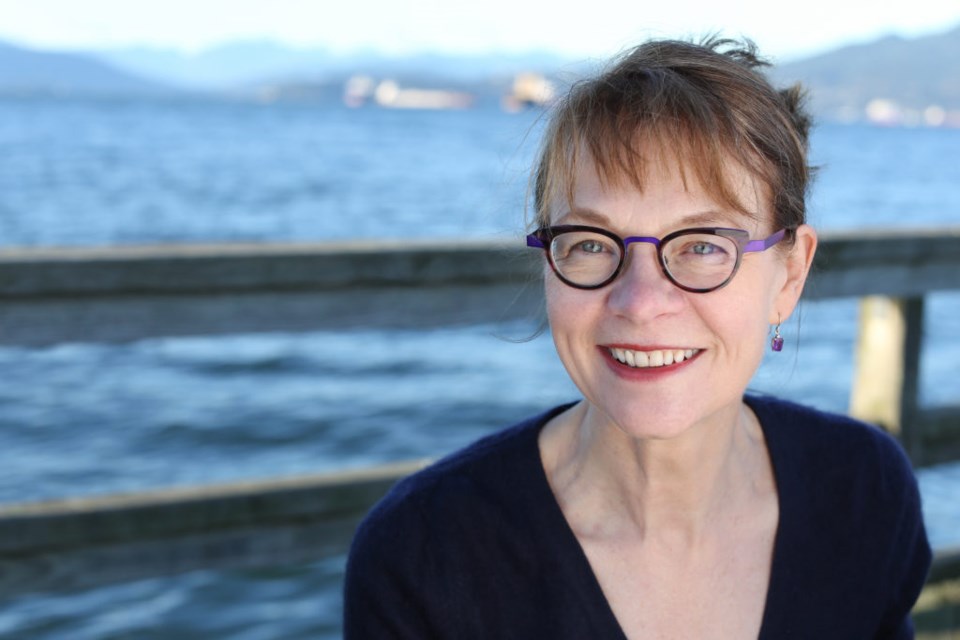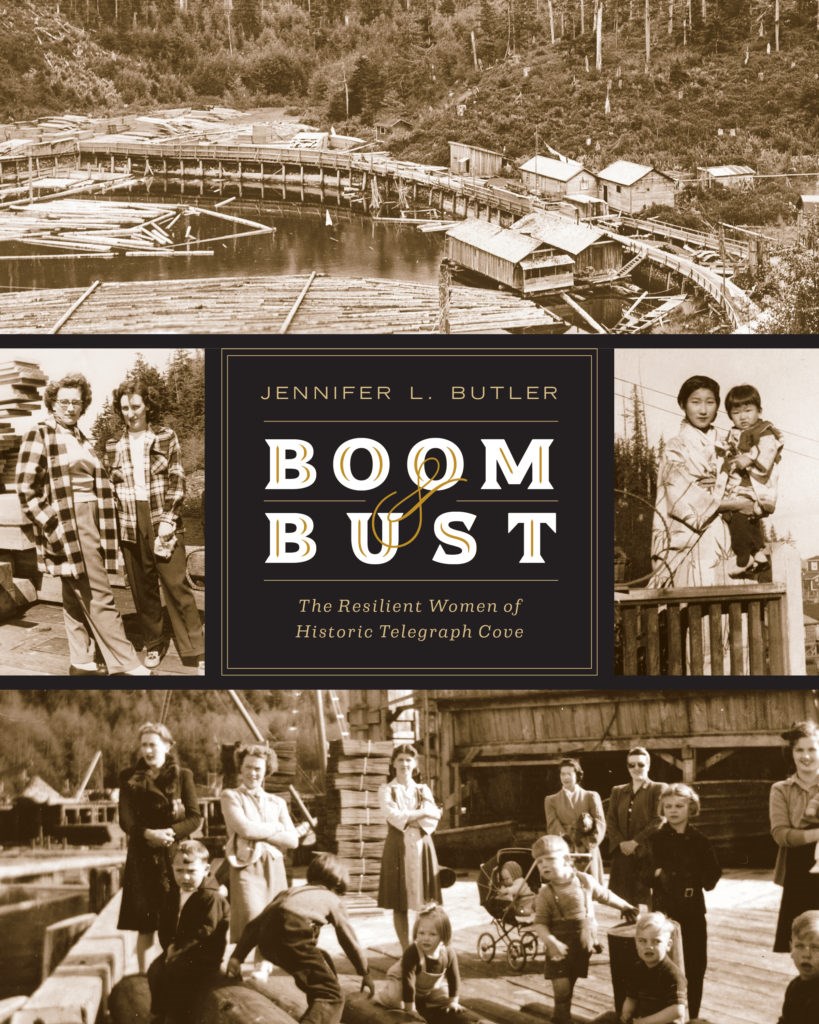Editor's note - Telegraph Cove, one of Vancouver Island’s most visited tourist destinations, has humble origins
as a one-shack telegraph station. The community grew, first with a salmon saltery sawmill, then with the new industries developed by the ingenuity of its Japanese, Chinese, German, Danish, Italian, Indian, American, Irish, Scottish, and English inhabitants - old and new Canadians, all neighbours in a place accessible only by boat.
Jennifer L. Butler is the great-granddaughter of Mame and Duke Wastell, who bought and named Telegraph Cove in 1912. In her book Boom & Bust - The Resilient Women of Historic Telegraph Cove, more than 25 women tell their own stories of a remarkable place.

You are the great-granddaughter of the founders of Telegraph Cove, Mame and Duke Wastell. Did you know your great-grandparents? Do you have memories of visiting the Cove as a child? Growing up, was their contribution to Telegraph Cove something of a conversation starter?
Jennifer Butler: I never knew my great-grandmother Mary Elizabeth Wastell, known as “Mame,” and I have only the barest childhood memory of my great-grandfather Alfred Marmaduke, aka “Duke,” who died when I was 3. But I knew my grandparents Emma and Fred Wastell very well.
During my childhood and adolescence, my parents and siblings and I went to Telegraph Cove every summer, and one memorable Christmas, and I worked in Telegraph Cove helping my grandmother cope with the household during my high school and university summers.
Those days, and the friendships I made there, were magical to a city-raised girl. At the time, I never really thought of my family as being the founders and landowners of the Cove. It was just the place where my grandparents lived and where all my summer friends were. My paternal grandparents lived on a farm in Haney, and my maternal grandparents lived in Telegraph Cove—I felt I was the luckiest of granddaughters to have those contrasting worlds available to me.
How do you describe Telegraph Cove to your friends who may not know where it is, much less have been there?
JB: When I was a child, no one had ever heard of Telegraph Cove, which was no surprise as its population was about 45 and the only way in was by boat. So I got used to immediately adding “on the north-east coast of Vancouver Island.”
Later on, I would add “across the strait from Alert Bay,” as that place was becoming known due to the rising interest in Kwakwaka’wakw First Nation culture. Now I get only so far into that description when someone invariably exclaims “I’ve been to Telegraph Cove!”
Now, about 100,000 people go there every summer for whale-watching and bear-watching tours, kayaking, fishing, camping, hiking and just visiting this preserved, historic mill town built on stilts around a boardwalk.
Was there a particular anecdote, story, or person who inspired you to write this book?
JB: While visiting the Cove in 2015 to take part in a ceremony honouring the role Telegraph Cove played during the Second World War (the Royal Canadian Air Force took over the entire village and the mill), I was struck by how frequently people asked me about my grandfather’s life, or my great-grandfather’s role in Telegraph Cove’s development. But no one ever asked me about my grandmother or my great-grandmother, both of whom I thought were actually more interesting people.
I decided then to write about them. But not only them. I would write about all the women who had lived in Telegraph Cove! Or at least as many of them as I could.
They were all interesting characters, and would make a much more interesting book than just a family history.
Tell me about the title – Boom & Bust.
JB: One of the women in the book refers to Telegraph Cove as a “boom-and-bust sort of place,” alluding to the rise and fall of its resource-based economy, which provided a great, short, alliterative phrase, but it needed the secondary title “The Resilient Women of Historic Telegraph Cove” to avoid leading people to surmise it is a book about economics!
Amusingly and coincidentally, while I was writing the book, my husband gave it the tongue-in-cheek working title of “Booms and Busts” which made me laugh, as this is a book about women living in a village filled with log booms.
So the title pretty much wrote itself.
As you researched the book, were there any stories that surprised you—something you never knew or had thought differently?
JB: It was delightful to discover connections between some of the women that occurred before and after their years living in Telegraph Cove. But the most dramatic discoveries I made were the result of the openness with which these women shared stories about the challenges they faced, stories that even one generation ago they would never have admitted to themselves, let alone disclosed to someone else.
Some women overcame issues related to extreme poverty, wartime internment, post-war immigration, domestic abuse, the deaths of their children, and even figuring out how to bake cakes in stoves fueled by damp sawdust!
Being sensitive and respectful was important to me right from the start. Collaborating closely with the women ensured their stories were written in a way that satisfied how they wanted their stories told, while remaining both authentic and honest. There are universal truths that connect all women, whether their lives are lived in urban or rural settings, a hundred years ago or in the present day.
Their characters reflect resilience to life’s obstacles and opportunities, and represent shoulders on which stand the current #MeToo and Times Up movements.
Today, only some 20 people live there full time. What do they think about Telegraph Cove’s past?
JB: As many as 20? I’d be surprised to hear there are more than 6 truly full-time residents of Telegraph Cove at present! (Editor’s note: Google isn’t always right – I defer to local knowledge.)
The ones I know personally who live there year-round love living there, surrounded by its history and nature. You’d have to! On a glorious, sunny summer day when the whales are passing and the fish are jumping, it is easy to forget just how grey and dark and wet and lonely it is during the offseason. There are storms with lashing winds and driving rains. The power goes out. Trees sometimes fall across the only road. Medical help is a half hour away by highway. You can’t even go out and get milk without an hour’s round-trip in a car or boat.
You need to be self-sufficient. I admire anyone who can live there and thrive. But for those who love the nature of the north Island, and have the right skill set, there is no better life you can create for yourself, or place to raise a family.
If people only take one thing from your book, what do you think it should or will be?
JB: That everyone has a story, and it is women who tend to have the most interesting ones, and are the most overlooked!
Finally, you’re based in Vancouver these days – do you ever see yourself (back) in or near Telegraph Cove?
JB: To live? No! I know I would be pretty useless dealing with the challenges of everyday life in such an isolated community. But every time I go to visit the Cove, a little piece of me deep inside blooms as it can nowhere else, like a rare forest orchid. And whenever I smell the combination of fresh cut lumber, creosote and boat gas, I am immediately taken right back to my childhood summers in Telegraph Cove!

Maclean Kay is Editor in Chief of The Orca


